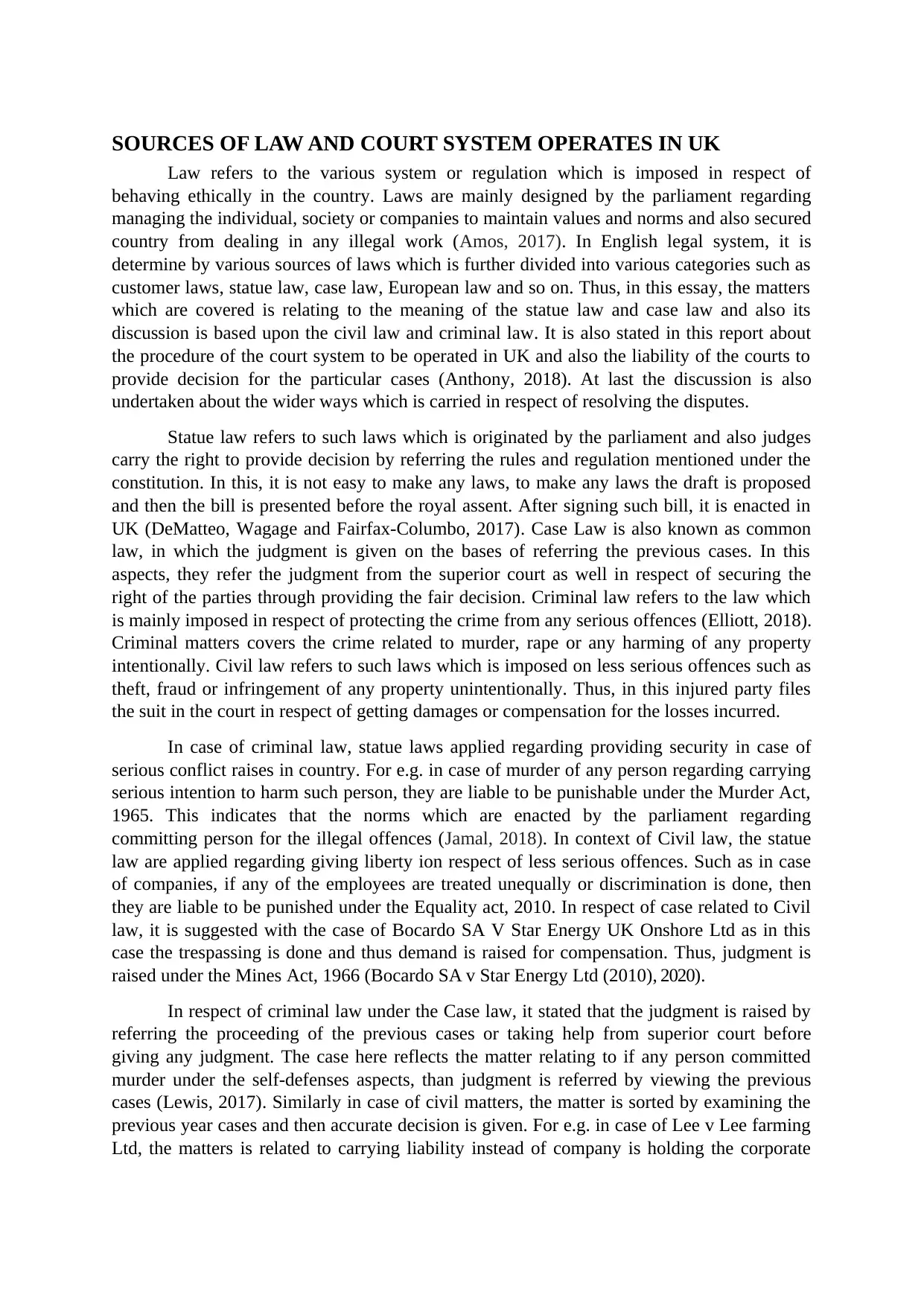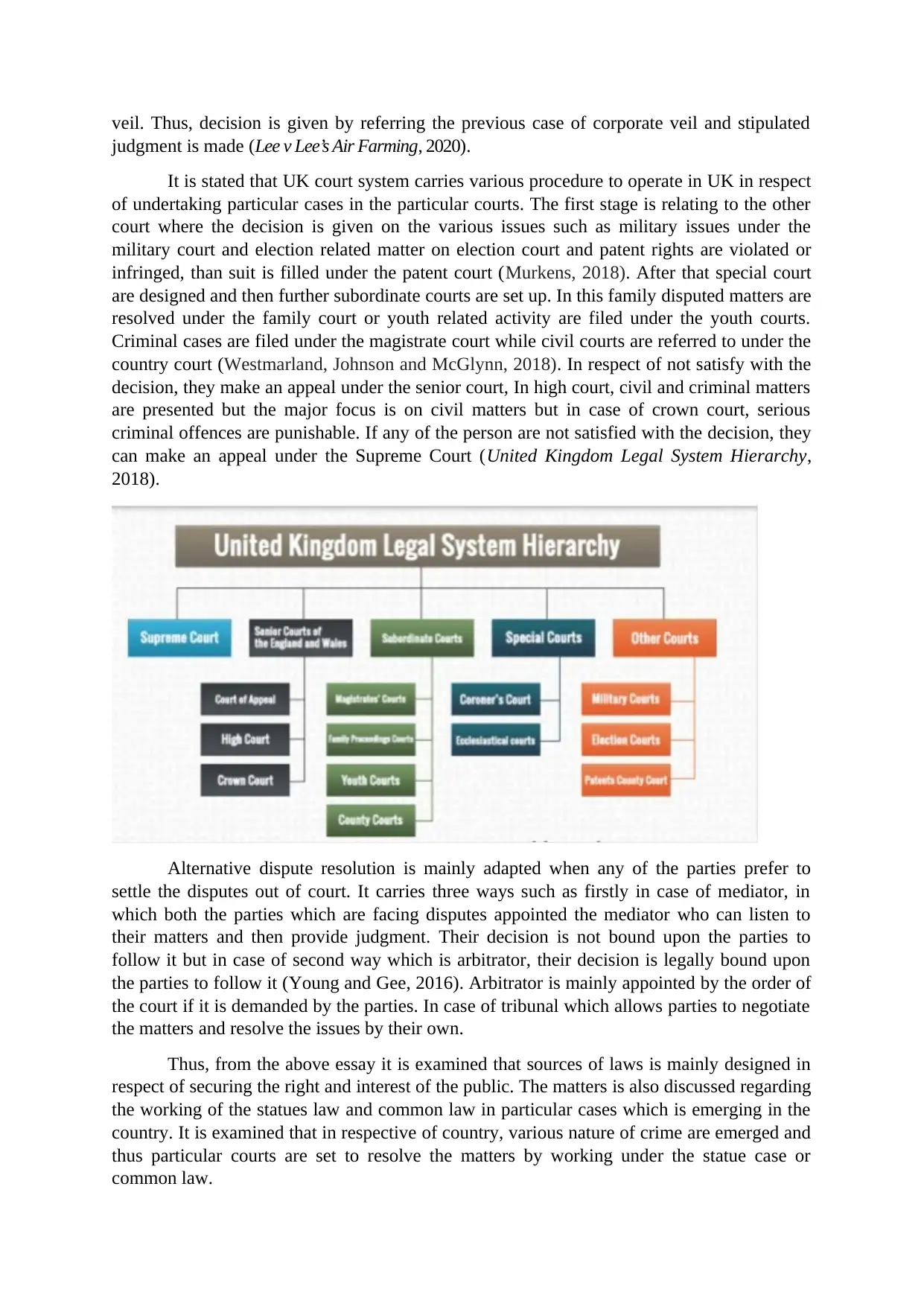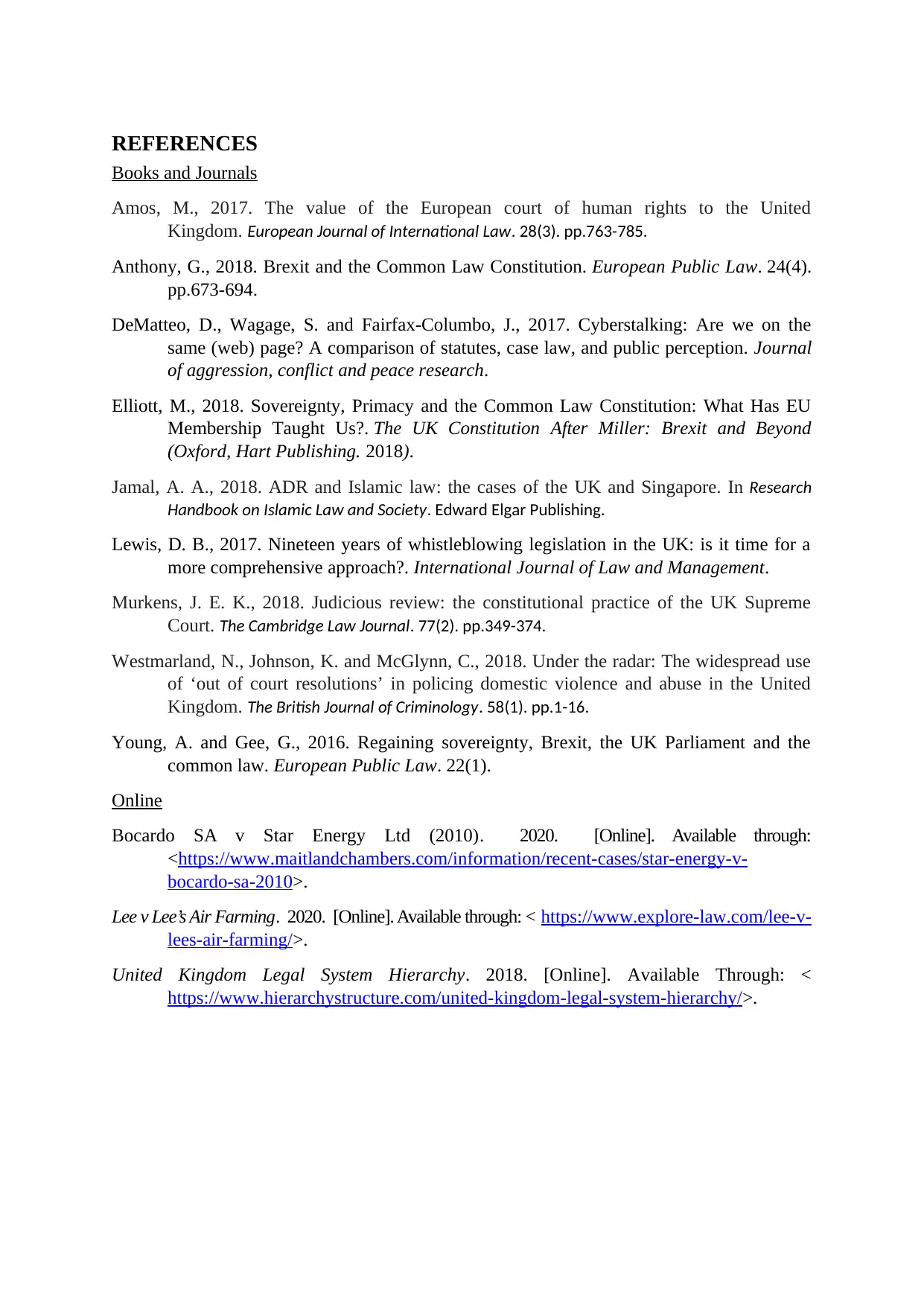Analysis of UK Law: Sources, Court System, and Dispute Resolution
VerifiedAdded on 2023/01/12
|5
|1625
|84
Essay
AI Summary
This essay provides a comprehensive overview of the UK legal system. It begins by defining law and exploring its various sources, including statute law, case law, and their distinctions. The essay then delves into criminal and civil law, illustrating how statute and case law are applied in both contexts with relevant examples such as the Murder Act 1965 and the Equality Act 2010. The analysis extends to the UK court system, detailing its structure from lower courts to the Supreme Court, and explaining how different types of cases are processed. The essay also covers alternative dispute resolution methods, such as mediation, arbitration, and tribunals, highlighting their significance. The essay concludes by summarizing the key aspects of the UK legal framework and its practical application, ensuring a well-rounded understanding of the subject matter. The essay refers to cases such as Bocardo SA v Star Energy UK Onshore Ltd and Lee v Lee’s Air Farming to support the arguments. This essay is a student contribution to Desklib, a platform offering AI-driven study tools for students.

BUSINESS LAW
Paraphrase This Document
Need a fresh take? Get an instant paraphrase of this document with our AI Paraphraser

SOURCES OF LAW AND COURT SYSTEM OPERATES IN UK
Law refers to the various system or regulation which is imposed in respect of
behaving ethically in the country. Laws are mainly designed by the parliament regarding
managing the individual, society or companies to maintain values and norms and also secured
country from dealing in any illegal work (Amos, 2017). In English legal system, it is
determine by various sources of laws which is further divided into various categories such as
customer laws, statue law, case law, European law and so on. Thus, in this essay, the matters
which are covered is relating to the meaning of the statue law and case law and also its
discussion is based upon the civil law and criminal law. It is also stated in this report about
the procedure of the court system to be operated in UK and also the liability of the courts to
provide decision for the particular cases (Anthony, 2018). At last the discussion is also
undertaken about the wider ways which is carried in respect of resolving the disputes.
Statue law refers to such laws which is originated by the parliament and also judges
carry the right to provide decision by referring the rules and regulation mentioned under the
constitution. In this, it is not easy to make any laws, to make any laws the draft is proposed
and then the bill is presented before the royal assent. After signing such bill, it is enacted in
UK (DeMatteo, Wagage and Fairfax-Columbo, 2017). Case Law is also known as common
law, in which the judgment is given on the bases of referring the previous cases. In this
aspects, they refer the judgment from the superior court as well in respect of securing the
right of the parties through providing the fair decision. Criminal law refers to the law which
is mainly imposed in respect of protecting the crime from any serious offences (Elliott, 2018).
Criminal matters covers the crime related to murder, rape or any harming of any property
intentionally. Civil law refers to such laws which is imposed on less serious offences such as
theft, fraud or infringement of any property unintentionally. Thus, in this injured party files
the suit in the court in respect of getting damages or compensation for the losses incurred.
In case of criminal law, statue laws applied regarding providing security in case of
serious conflict raises in country. For e.g. in case of murder of any person regarding carrying
serious intention to harm such person, they are liable to be punishable under the Murder Act,
1965. This indicates that the norms which are enacted by the parliament regarding
committing person for the illegal offences (Jamal, 2018). In context of Civil law, the statue
law are applied regarding giving liberty ion respect of less serious offences. Such as in case
of companies, if any of the employees are treated unequally or discrimination is done, then
they are liable to be punished under the Equality act, 2010. In respect of case related to Civil
law, it is suggested with the case of Bocardo SA V Star Energy UK Onshore Ltd as in this
case the trespassing is done and thus demand is raised for compensation. Thus, judgment is
raised under the Mines Act, 1966 (Bocardo SA v Star Energy Ltd (2010), 2020).
In respect of criminal law under the Case law, it stated that the judgment is raised by
referring the proceeding of the previous cases or taking help from superior court before
giving any judgment. The case here reflects the matter relating to if any person committed
murder under the self-defenses aspects, than judgment is referred by viewing the previous
cases (Lewis, 2017). Similarly in case of civil matters, the matter is sorted by examining the
previous year cases and then accurate decision is given. For e.g. in case of Lee v Lee farming
Ltd, the matters is related to carrying liability instead of company is holding the corporate
Law refers to the various system or regulation which is imposed in respect of
behaving ethically in the country. Laws are mainly designed by the parliament regarding
managing the individual, society or companies to maintain values and norms and also secured
country from dealing in any illegal work (Amos, 2017). In English legal system, it is
determine by various sources of laws which is further divided into various categories such as
customer laws, statue law, case law, European law and so on. Thus, in this essay, the matters
which are covered is relating to the meaning of the statue law and case law and also its
discussion is based upon the civil law and criminal law. It is also stated in this report about
the procedure of the court system to be operated in UK and also the liability of the courts to
provide decision for the particular cases (Anthony, 2018). At last the discussion is also
undertaken about the wider ways which is carried in respect of resolving the disputes.
Statue law refers to such laws which is originated by the parliament and also judges
carry the right to provide decision by referring the rules and regulation mentioned under the
constitution. In this, it is not easy to make any laws, to make any laws the draft is proposed
and then the bill is presented before the royal assent. After signing such bill, it is enacted in
UK (DeMatteo, Wagage and Fairfax-Columbo, 2017). Case Law is also known as common
law, in which the judgment is given on the bases of referring the previous cases. In this
aspects, they refer the judgment from the superior court as well in respect of securing the
right of the parties through providing the fair decision. Criminal law refers to the law which
is mainly imposed in respect of protecting the crime from any serious offences (Elliott, 2018).
Criminal matters covers the crime related to murder, rape or any harming of any property
intentionally. Civil law refers to such laws which is imposed on less serious offences such as
theft, fraud or infringement of any property unintentionally. Thus, in this injured party files
the suit in the court in respect of getting damages or compensation for the losses incurred.
In case of criminal law, statue laws applied regarding providing security in case of
serious conflict raises in country. For e.g. in case of murder of any person regarding carrying
serious intention to harm such person, they are liable to be punishable under the Murder Act,
1965. This indicates that the norms which are enacted by the parliament regarding
committing person for the illegal offences (Jamal, 2018). In context of Civil law, the statue
law are applied regarding giving liberty ion respect of less serious offences. Such as in case
of companies, if any of the employees are treated unequally or discrimination is done, then
they are liable to be punished under the Equality act, 2010. In respect of case related to Civil
law, it is suggested with the case of Bocardo SA V Star Energy UK Onshore Ltd as in this
case the trespassing is done and thus demand is raised for compensation. Thus, judgment is
raised under the Mines Act, 1966 (Bocardo SA v Star Energy Ltd (2010), 2020).
In respect of criminal law under the Case law, it stated that the judgment is raised by
referring the proceeding of the previous cases or taking help from superior court before
giving any judgment. The case here reflects the matter relating to if any person committed
murder under the self-defenses aspects, than judgment is referred by viewing the previous
cases (Lewis, 2017). Similarly in case of civil matters, the matter is sorted by examining the
previous year cases and then accurate decision is given. For e.g. in case of Lee v Lee farming
Ltd, the matters is related to carrying liability instead of company is holding the corporate

veil. Thus, decision is given by referring the previous case of corporate veil and stipulated
judgment is made (Lee v Lee’s Air Farming, 2020).
It is stated that UK court system carries various procedure to operate in UK in respect
of undertaking particular cases in the particular courts. The first stage is relating to the other
court where the decision is given on the various issues such as military issues under the
military court and election related matter on election court and patent rights are violated or
infringed, than suit is filled under the patent court (Murkens, 2018). After that special court
are designed and then further subordinate courts are set up. In this family disputed matters are
resolved under the family court or youth related activity are filed under the youth courts.
Criminal cases are filed under the magistrate court while civil courts are referred to under the
country court (Westmarland, Johnson and McGlynn, 2018). In respect of not satisfy with the
decision, they make an appeal under the senior court, In high court, civil and criminal matters
are presented but the major focus is on civil matters but in case of crown court, serious
criminal offences are punishable. If any of the person are not satisfied with the decision, they
can make an appeal under the Supreme Court (United Kingdom Legal System Hierarchy,
2018).
Alternative dispute resolution is mainly adapted when any of the parties prefer to
settle the disputes out of court. It carries three ways such as firstly in case of mediator, in
which both the parties which are facing disputes appointed the mediator who can listen to
their matters and then provide judgment. Their decision is not bound upon the parties to
follow it but in case of second way which is arbitrator, their decision is legally bound upon
the parties to follow it (Young and Gee, 2016). Arbitrator is mainly appointed by the order of
the court if it is demanded by the parties. In case of tribunal which allows parties to negotiate
the matters and resolve the issues by their own.
Thus, from the above essay it is examined that sources of laws is mainly designed in
respect of securing the right and interest of the public. The matters is also discussed regarding
the working of the statues law and common law in particular cases which is emerging in the
country. It is examined that in respective of country, various nature of crime are emerged and
thus particular courts are set to resolve the matters by working under the statue case or
common law.
judgment is made (Lee v Lee’s Air Farming, 2020).
It is stated that UK court system carries various procedure to operate in UK in respect
of undertaking particular cases in the particular courts. The first stage is relating to the other
court where the decision is given on the various issues such as military issues under the
military court and election related matter on election court and patent rights are violated or
infringed, than suit is filled under the patent court (Murkens, 2018). After that special court
are designed and then further subordinate courts are set up. In this family disputed matters are
resolved under the family court or youth related activity are filed under the youth courts.
Criminal cases are filed under the magistrate court while civil courts are referred to under the
country court (Westmarland, Johnson and McGlynn, 2018). In respect of not satisfy with the
decision, they make an appeal under the senior court, In high court, civil and criminal matters
are presented but the major focus is on civil matters but in case of crown court, serious
criminal offences are punishable. If any of the person are not satisfied with the decision, they
can make an appeal under the Supreme Court (United Kingdom Legal System Hierarchy,
2018).
Alternative dispute resolution is mainly adapted when any of the parties prefer to
settle the disputes out of court. It carries three ways such as firstly in case of mediator, in
which both the parties which are facing disputes appointed the mediator who can listen to
their matters and then provide judgment. Their decision is not bound upon the parties to
follow it but in case of second way which is arbitrator, their decision is legally bound upon
the parties to follow it (Young and Gee, 2016). Arbitrator is mainly appointed by the order of
the court if it is demanded by the parties. In case of tribunal which allows parties to negotiate
the matters and resolve the issues by their own.
Thus, from the above essay it is examined that sources of laws is mainly designed in
respect of securing the right and interest of the public. The matters is also discussed regarding
the working of the statues law and common law in particular cases which is emerging in the
country. It is examined that in respective of country, various nature of crime are emerged and
thus particular courts are set to resolve the matters by working under the statue case or
common law.
⊘ This is a preview!⊘
Do you want full access?
Subscribe today to unlock all pages.

Trusted by 1+ million students worldwide

Paraphrase This Document
Need a fresh take? Get an instant paraphrase of this document with our AI Paraphraser

REFERENCES
Books and Journals
Amos, M., 2017. The value of the European court of human rights to the United
Kingdom. European Journal of International Law. 28(3). pp.763-785.
Anthony, G., 2018. Brexit and the Common Law Constitution. European Public Law. 24(4).
pp.673-694.
DeMatteo, D., Wagage, S. and Fairfax-Columbo, J., 2017. Cyberstalking: Are we on the
same (web) page? A comparison of statutes, case law, and public perception. Journal
of aggression, conflict and peace research.
Elliott, M., 2018. Sovereignty, Primacy and the Common Law Constitution: What Has EU
Membership Taught Us?. The UK Constitution After Miller: Brexit and Beyond
(Oxford, Hart Publishing. 2018).
Jamal, A. A., 2018. ADR and Islamic law: the cases of the UK and Singapore. In Research
Handbook on Islamic Law and Society. Edward Elgar Publishing.
Lewis, D. B., 2017. Nineteen years of whistleblowing legislation in the UK: is it time for a
more comprehensive approach?. International Journal of Law and Management.
Murkens, J. E. K., 2018. Judicious review: the constitutional practice of the UK Supreme
Court. The Cambridge Law Journal. 77(2). pp.349-374.
Westmarland, N., Johnson, K. and McGlynn, C., 2018. Under the radar: The widespread use
of ‘out of court resolutions’ in policing domestic violence and abuse in the United
Kingdom. The British Journal of Criminology. 58(1). pp.1-16.
Young, A. and Gee, G., 2016. Regaining sovereignty, Brexit, the UK Parliament and the
common law. European Public Law. 22(1).
Online
Bocardo SA v Star Energy Ltd (2010). 2020. [Online]. Available through:
<https://www.maitlandchambers.com/information/recent-cases/star-energy-v-
bocardo-sa-2010>.
Lee v Lee’s Air Farming. 2020. [Online]. Available through: < https://www.explore-law.com/lee-v-
lees-air-farming/>.
United Kingdom Legal System Hierarchy. 2018. [Online]. Available Through: <
https://www.hierarchystructure.com/united-kingdom-legal-system-hierarchy/>.
Books and Journals
Amos, M., 2017. The value of the European court of human rights to the United
Kingdom. European Journal of International Law. 28(3). pp.763-785.
Anthony, G., 2018. Brexit and the Common Law Constitution. European Public Law. 24(4).
pp.673-694.
DeMatteo, D., Wagage, S. and Fairfax-Columbo, J., 2017. Cyberstalking: Are we on the
same (web) page? A comparison of statutes, case law, and public perception. Journal
of aggression, conflict and peace research.
Elliott, M., 2018. Sovereignty, Primacy and the Common Law Constitution: What Has EU
Membership Taught Us?. The UK Constitution After Miller: Brexit and Beyond
(Oxford, Hart Publishing. 2018).
Jamal, A. A., 2018. ADR and Islamic law: the cases of the UK and Singapore. In Research
Handbook on Islamic Law and Society. Edward Elgar Publishing.
Lewis, D. B., 2017. Nineteen years of whistleblowing legislation in the UK: is it time for a
more comprehensive approach?. International Journal of Law and Management.
Murkens, J. E. K., 2018. Judicious review: the constitutional practice of the UK Supreme
Court. The Cambridge Law Journal. 77(2). pp.349-374.
Westmarland, N., Johnson, K. and McGlynn, C., 2018. Under the radar: The widespread use
of ‘out of court resolutions’ in policing domestic violence and abuse in the United
Kingdom. The British Journal of Criminology. 58(1). pp.1-16.
Young, A. and Gee, G., 2016. Regaining sovereignty, Brexit, the UK Parliament and the
common law. European Public Law. 22(1).
Online
Bocardo SA v Star Energy Ltd (2010). 2020. [Online]. Available through:
<https://www.maitlandchambers.com/information/recent-cases/star-energy-v-
bocardo-sa-2010>.
Lee v Lee’s Air Farming. 2020. [Online]. Available through: < https://www.explore-law.com/lee-v-
lees-air-farming/>.
United Kingdom Legal System Hierarchy. 2018. [Online]. Available Through: <
https://www.hierarchystructure.com/united-kingdom-legal-system-hierarchy/>.
1 out of 5
Related Documents
Your All-in-One AI-Powered Toolkit for Academic Success.
+13062052269
info@desklib.com
Available 24*7 on WhatsApp / Email
![[object Object]](/_next/static/media/star-bottom.7253800d.svg)
Unlock your academic potential
Copyright © 2020–2025 A2Z Services. All Rights Reserved. Developed and managed by ZUCOL.





